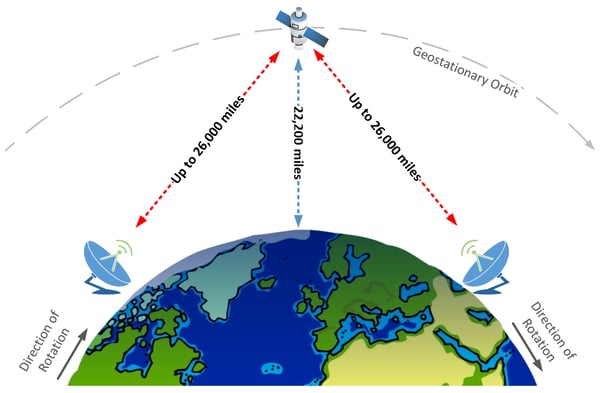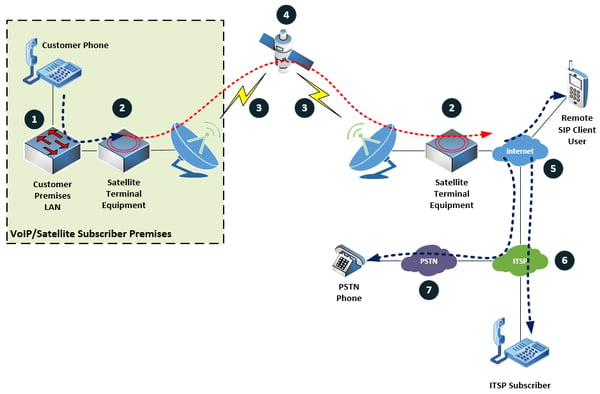
One of the most groundbreaking advantages of voice over IP technology is that, with the proper configurations, it is possible to install a voice endpoint anywhere in the world, as long as internet connectivity is available. But what happens if it is unavailable? For such cases, satellite access technology is quickly becoming an economically and technically viable solution.
Employing VoIP services over a satellite link can sometimes be challenging, due to the unique idiosyncrasies of the technology. In this article, we examine satellite internet links and how you can optimize VoIP implementation over satellite.
Satellite internet solutions
Satellite communications have been around for decades, but only recently have they been made more accessible to businesses and the general public. Even so, satellite internet services are a little too expensive to compete with xDSL, cable, and cellular infrastructures, and a little too slow to compete with fiber optic networks. This, coupled with the near-saturation of internet connectivity for most urban areas in the world, has forced satellite access technologies into a niche market, servicing rural areas, remote installations, and specialized scenarios such as shipping, off-shore oil rigs and mining, to name a few.
This is extremely convenient for the implementation of VoIP applications in remote and inaccessible areas, since if you have internet connectivity, you can easily obtain a VoIP service over that link. However, satellite links have several disadvantages for VoIP, the most prominent being the transmission delay they introduce.
How satellite links work
Communications satellites are placed in what is known as a geostationary orbit around the Earth at a distance of about 22,200 miles above the equator. At this exact distance, a satellite will orbit the Earth in synch with the Earth’s rotation. To ground observers, a satellite in such an orbit will appear motionless at a fixed position in the sky. This is advantageous because Earth-based satellite antennas do not have to rotate and track the satellite over the course of a day, but rather can remain pointed permanently at the position in the sky where the satellite is located. The following image illustrates this concept by showing the relative position of two geostationary satellites to that of the surface of the rotating Earth.

This orbital distance, although beneficial for pointing satellite antennas, introduces an inherent delay in satellite transmissions due to the sheer distances the signals must travel. The following image shows the distance between a satellite and two ground stations, which is at least 22,000 miles and can be up to 26,000 miles, depending on the relative position of the satellite and the ground stations.

Even at the speed of light, signals travelling from one ground station to another via the communications satellite will add anywhere between 240ms and 280 milliseconds of delay. If we add signal processing time at both base stations and at the satellite itself, delays can reach anywhere from 500 to 1000ms, something which is devastating for VoIP communications.
Acceptable delay for VoIP
The following table comes from the ITU’s G.114 recommendation on acceptable one-way transmission times for high-quality VoIP communications:
|
Quality |
One-way transmission time |
Effect of delay on human voice perception |
|
Ideal |
0 – 150ms |
Acceptable for most users |
|
Acceptable |
150 – 400ms |
Acceptable, but has impact |
|
Unacceptable |
400 – 600ms |
Unacceptable but somewhat intelligible |
|
Unintelligible |
> 600ms |
Unintelligible and incoherent |
Satellite links are already in violation of the ideal quality, but with the appropriate care, can be made to achieve the acceptable quality level.
Determining delay
To evaluate the impact that a satellite link may have on your VoIP implementation, you must evaluate the amount of delay that is expected for your VoIP calls. The following diagram shows a satellite and VoIP subscriber and the various types of VoIP calls that may be made, including calls to the PSTN, to other subscribers on the same ITSP as the customer, as well as calls to remote SIP clients that may belong to the same subscriber.
 The dark blue transmissions are those that are expected for any non-satellite implementation, and contribute a nominal amount of one-way delay, typically less than 150ms. The red transmissions are those unique to satellite connectivity. It is the total end-to-end delay time that must be determined, of which the satellite component contributes a considerable amount.
The dark blue transmissions are those that are expected for any non-satellite implementation, and contribute a nominal amount of one-way delay, typically less than 150ms. The red transmissions are those unique to satellite connectivity. It is the total end-to-end delay time that must be determined, of which the satellite component contributes a considerable amount.
Transmission delay can be introduced in any of the following areas. The numbers correspond to those in the diagram above:
- Internal customer premises LAN
- Signal processing time taken by the satellite terminal equipment
- Propagation of the signal to and from the satellite
- Signal processing time taken by the satellite itself
- Transmission time over the internet
- Transmission time within the ITSP network
- Transmission time within the PSTN
Delay mitigation strategies for VoIP over satellite implementations
Needless to say, any delay mitigation strategies must be implemented in areas of the network over which you have administrative control. Unless you are able to change the laws of physics, you will be unable to do anything about the delay due to the propagation of the signal itself. The areas over which you do have some level of control include:
- Customer LAN
- Satellite terminal equipment
- Choice of ITSP
- Choice of implementation for remote SIP clients
Some specific things you should do to ensure the least amount of delay in your implementation include:
Employ QoS mechanisms in your customer’s LAN – Whenever VoIP is involved, QoS mechanisms should always be employed. This ensures that no delay will be added to your VoIP communications caused by local network congestion. QoS will also allow you to transmit voice packets over the satellite link with priority, so that any congestion of the link itself will not affect the transmission delay.
Choose appropriate satellite terminal equipment – Contact your satellite provider to ensure that the satellite terminal equipment being used is fast enough to introduce as little delay as possible from signal processing procedures. The devices available today are quite powerful and can reduce processing delay to several tens of milliseconds.
Choice of ITSP – If you are connecting your VoIP network via either a SIP trunk or a series of SIP extensions, talk to your ITSP and let them know that you are connecting over a satellite link. They may be able to accommodate you with configuration parameters that will speed up SIP registration and packet propagation.
Remote SIP clients – Many remote clients will use a VPN to secure their VoIP connectivity. VPNs will always add overhead and therefore delay to voice transmissions. Ensure that you have configured VPN parameters so that they minimize this overhead.
Using a dedicated VoIP over satellite provider
The solutions described above involve using ITSPs and the services and infrastructure that you would use in a conventional enterprise network. There are several companies, however, that specialize in delivering VoIP over satellite. These businesses have developed complete end-to-end solutions that will ensure a minimum impact on your voice communications from delay. This is achieved by using high-speed signal processing, dedicated satellite link channels, advanced voice codecs, and a robust QoS implementation within their networks. Such a solution may be preferable for larger VoIP implementations that leverage satellite communications.
Conclusion
Remote rural communities, isolated industrial services, and specialized business applications can all benefit from the “connect from anywhere” capability that satellite internet access provides. When coupled with appropriately designed and configured VoIP services, satellite internet connectivity can deliver a complete business communications solution anywhere, for almost any business need.
You may also like
5G and its applications for UC
How to optimize your WAN connectivity for VoIP
Key considerations for choosing a high-grade WAN technology
Know your stuff: commercial-grade WAN technologies









Comments